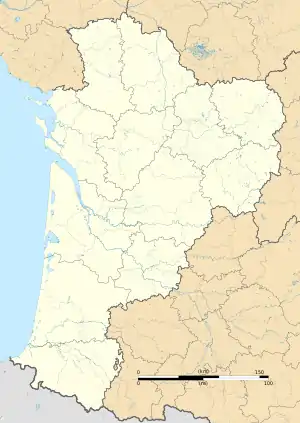Brassempouy
Brassempouy is a commune in the Landes department in Nouvelle-Aquitaine in southwestern France.
Brassempouy | |
|---|---|
 | |
Location of Brassempouy 
| |
 Brassempouy  Brassempouy | |
| Coordinates: 43°37′58″N 0°41′37″W | |
| Country | France |
| Region | Nouvelle-Aquitaine |
| Department | Landes |
| Arrondissement | Dax |
| Canton | Coteau de Chalosse |
| Government | |
| • Mayor (2014–2020) | Guy Duplantier |
| Area 1 | 10.72 km2 (4.14 sq mi) |
| Population (2017-01-01)[1] | 267 |
| • Density | 25/km2 (65/sq mi) |
| Time zone | UTC+01:00 (CET) |
| • Summer (DST) | UTC+02:00 (CEST) |
| INSEE/Postal code | 40054 /40330 |
| Elevation | 35–131 m (115–430 ft) (avg. 120 m or 390 ft) |
| 1 French Land Register data, which excludes lakes, ponds, glaciers > 1 km2 (0.386 sq mi or 247 acres) and river estuaries. | |
The settlement is on the route between Mont-de-Marsan and Orthez.
Population
| Year | Pop. | ±% |
|---|---|---|
| 1962 | 307 | — |
| 1968 | 332 | +8.1% |
| 1975 | 309 | −6.9% |
| 1982 | 291 | −5.8% |
| 1990 | 279 | −4.1% |
| 1999 | 268 | −3.9% |
| 2006 | 289 | +7.8% |
| 2013 | 276 | −4.5% |
Prehistoric caves
The village became famous for its two nearby caves, and only 100 metres from each other, were among the first Paleolithic sites to be explored in France. They are known as the Galerie des Hyènes (Gallery of the Hyenas) and the Grotte du Pape (the "Pope's Cave"), in which the Venus of Brassempouy was discovered in 1892, accompanied by eight other human figures, often ignored, and an example of unfinished work, with multiple figures of women being carved at the same time. As a result, the four museums of history were established here.
See also
References
- "Populations légales 2017". INSEE. Retrieved 6 January 2020.
| Wikimedia Commons has media related to Brassempouy. |
This article is issued from Wikipedia. The text is licensed under Creative Commons - Attribution - Sharealike. Additional terms may apply for the media files.



